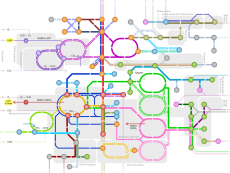

Glycolysis and metabolism
What is glycolysis?
Glycolysis is the first stage out of a series of stages of cellular respiration. It is an anaerobic process as it can take place in both aerobic and anaerobic conditions, thus it does not require oxygen. In this stage, glucose is converted into a product enabling it to enter the citric acid cycle (a later stage in respiration.) Additionally, the breakdown of other molecules can also feed into glycolysis. Essentially, glycolysis is part of an extensive metabolic pathway.
Why do we need metabolic pathways?
Without a multistep pathway, we would have uncontrolled combustion, this would lead to a large outburst of energy, this is not useful. Instead, we need short bursts of energy being released at set stages to enable efficient energy exchange, thus we get an energy conserving pathway. We do not want to waste energy so it is important to control these pathways.
Why do we metabolise glucose?
Glucose is very useful for many reasons. We need glucose for not only respiration but for carbon skeleton biosynthesis. Glucose enables the provision of energy, it is central to our metabolism.
Where we have glucose, it does not have to take the same route. Instead glucose can be converted into glycogen (glycogenesis) to store the glucose in the liver to be used at a later date. This form of storage prevents blood glucose levels being too high (negative feedback.) Adversely, glucose can be converted into ribose (a pentose sugar) which can be used for ribonucleic acid (RNA.) Committing to a step of pathway is tightly controlled, known as a control point, as we must respond to the environment correctly to maintain homeostasis.
When looking at metabolic pathways, there are some aspects we should consider making sure we have a full understanding. Firstly, where does it occur in the cell? Is it branched? If not, Is it linear? Where does it begin, where does it end? What are the end products? Does it link to other pathways, if so, which ones? What happens in each step? Is it reversible-how? What are the key control points? How is regulated? If you can answer all of these questions then you can confidently explain the metabolic pathway to your peers.
There are different types of reactions which can take place in metabolism, these are as follows: oxidation- reduction, ligation, isomerization, group transfer, hydrolysis, and addition or removal of functional groups. Oxidation/ reduction reactions are where electrons are transferred, an easy to remember which way they are transferred is the acronym OIL RIG. OIL RIG stands for Oxidation Is Loss, Reduction Is Gain. Thus, in oxidative reactions, the reducing agent will transfer its electrons to another molecule (thus losing electrons.) For reduction, the oxidising agent will gain electrons. This can be shortened to redox reactions.
Ligation reactions require ATP and form a covalent bond, meaning two molecules will join together. Isomerization is the rearrangement of atoms in a structure to form isomers. Isomers are two molecules that have the same structural formula but a different molecular arrangement. Group transfers involve the movement of functional groups from one molecule to another. Hydrolysis is the breakdown of a molecule using a molecule one water, water cleaves the bonds.
Image Credits:
https://upload.wikimedia.org/wikipedia/commons/thumb/4/41/Metabolic_Metro_Map_%28no_legends%29.svg/800px-Metabolic_Metro_Map_%28no_legends%29.svg.png

0 Comment:
Be the first one to comment on this article.